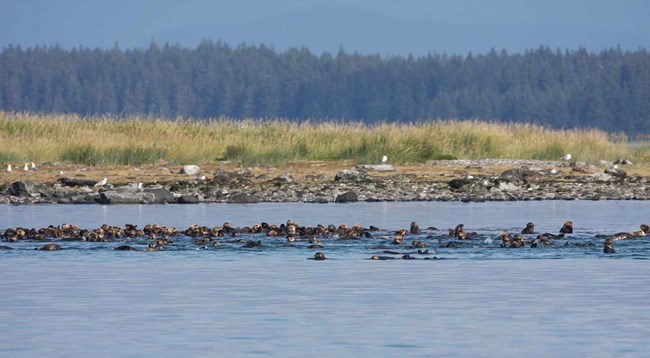
Sea otters are a keystone species in nearshore marine environments. A keystone species dramatically affects the structure and complexity of their environment. For example, when sea otters are present in rocky habitats, they eat sea urchins and urchin density decreases as a result. Lower urchin density reduces grazing pressure on kelps, resulting in a more diverse nearshore ecosystem. And sea otters are voracious; to survive in their cold-water environment, sea otters must consume 20-30% of their body weight in food each day.
By 1900, sea otters had been exterminated from nearly the entire North Pacific Ocean. No populations existed from Prince William Sound, Alaska to Big Sur, California. In 1911, the International Fur Treaty provided the few hundred remaining sea otters with their first measure of protection. In the late 1960s, 413 sea otters were transplanted to several locations in Southeast Alaska and the population began a remarkable recovery. Sea otters began to colonize Glacier Bay in 1988, and they have expanded rapidly.
The methods used for monitoring include high-quality digital images from aircraft flying transects. The images are analyzed to count individuals and distinguish between adults and immature animals and models are used to estimate population numbers and distribution. The primary monitoring objectives are to:
-
Monitor the abundance and spatial distribution of sea otters in Glacier Bay National Park and Preserve.
-
Provide a dynamic spatio-temporal model using a flexible statistical framework that can accommodate multiple data types.
-
Implement optimal dynamic survey designs to increase sampling efficiency to maximize program sustainability, increase safety, and improve the precision of parameter estimates.
-
Provide reliable quantitative information regarding the spatial distribution and abundance of sea otters to assess their status in Glacier Bay National Park and Preserve and inform decisions regarding management actions that may have the potential to impact sea otters.
We monitor sea otters in Glacier Bay National Park and Preserve (read the monitoring protocol).
Contact: Jamie Womble
Learn more
Last updated: November 16, 2023
